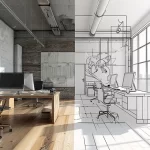Understanding the Different Types of Patent Drawings: A Comprehensive Analysis for the Astute Attorney
- October 7, 2023
- By Sarita Thomas
- Read 3 minutes
To the discerning legal professional, patent drawings serve as a pivotal touchstone, translating abstract ideas into tangible visuals that fortify the written word.
The complexity of the patent drawing universe is underscored by its diverse types, each tailored to encapsulate specific facets of an invention. As we plunge deeper into this world, it’s evident that understanding the nuances between utility drawings, design drawings, and flowcharts is not a mere advantage but a necessity. Let’s embark on a detailed exploration of these patent drawing types and their indispensable roles.
Utility Drawings and Decoding the Functional Essence
Often likened to architectural blueprints, utility drawings provide a detailed window into the core functional attributes of an invention. They traverse beyond superficial layers, delving into the intricate mechanics, components, and processes that underpin the invention’s operation.
For inventions that are groundbreaking in terms of their methodologies or unique mechanisms—think a novel medical device or a revolutionary manufacturing tool—utility drawings emerge as non-negotiable. They breathe life into claims that revolve around the functional aspects of an invention, ensuring that patent examiners and potential licensees can visually grasp the invention’s operational nuances. Moreover, in legal skirmishes where the functionality of an invention is under the microscope, utility drawings often stand as robust pillars supporting defense arguments.
However, crafting a comprehensive utility drawing demands more than mere artistic prowess. It requires an intimate understanding of the invention’s workings, a meticulous eye for detail, and the ability to distill complex operations into clear, discernible visuals. For attorneys, recognizing the depth and breadth that utility drawings must encompass is the first step in ensuring their effectiveness.
Design Drawings: Capturing Aesthetic Mastery
Contrasting sharply with utility drawings, design drawings are the masterful artists of the patent illustration world. They zero in on the ornamental or visual attributes of an invention, completely sidelining its functionality. If one were to consider an elegantly designed piece of furniture or a uniquely shaped bottle, it’s the design drawings that would capture their distinct aesthetic appeal.
The importance of design drawings is magnified when the patent claim centers around the novel appearance of an item. Here, the challenge lies in encapsulating the essence of the design, ensuring every curve, contour, and texture is vividly portrayed. For attorneys managing cases where the visual uniqueness of a product is the heart of the claim, comprehending the intricacies of design drawings becomes paramount. In instances of potential design infringement, these drawings stand as testimonials of originality, becoming pivotal evidence in legal battles.
Flowcharts: Mapping the Intellectual Labyrinth
As we navigate to the technological sphere, particularly the burgeoning domain of software or method patents, the realm of flowcharts awaits. Distinct from the tangible realms illuminated by utility and design drawings, flowcharts construct a visual narrative of sequences, algorithms, or processes.
In the age of digital transformation, innovations within the software sector have gained unprecedented momentum. Consequently, flowcharts, with their ability to structure and sequence operations logically, have become the bedrock of numerous patent applications. They unravel the complexity of algorithms, ensuring that patent examiners, potential licensees, or legal adversaries can trace the logical journey of the software or method in question.
The challenge, however, is multi-fold. First, the flowchart must be comprehensive, leaving no logical stone unturned. Secondly, it must maintain clarity, ensuring that even those not deeply familiar with the specific software realm can follow the logic. For attorneys entrenched in software patent cases, mastering the art of interpreting and leveraging flowcharts is vital.
Concluding Reflections: Navigating the Patent Drawing Spectrum
The landscape of patent drawings is vast and varied, mirroring the incredible breadth of human innovation. For attorneys, these drawings aren’t mere adjuncts to textual descriptions; they are the visual linchpins that can determine the fate of patent applications or legal confrontations.
In our journey through utility drawings, design drawings, and flowcharts, one theme emerges consistently: the need for precision, depth, and clarity. These aren’t just artistic renditions but meticulously crafted illustrations that must stand up to legal scrutiny, align with patent office standards, and capture the essence of the innovation at hand.
As intellectual property law continues to evolve, fueled by rapid technological advancements and changing market dynamics, the role of patent drawings will only magnify. For the astute attorney, deepening their understanding of these drawings isn’t just a pursuit of knowledge—it’s an investment in future success.







